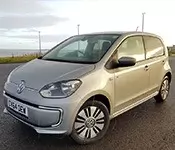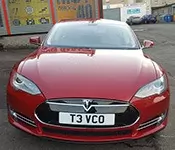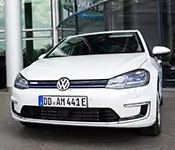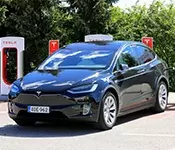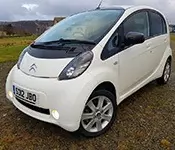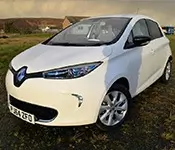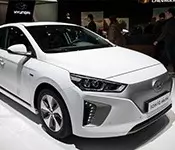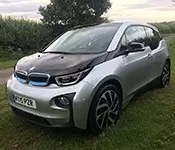The Best Electric Cars
Inverness, Aberdeen, Dundee, Glasgow, Edinburgh
Do you want to know more about the best electric cars to buy near you? The guide below offers details about the most popular electric cars available in the UK.
The future is here. More of us are realising the benefits of electric cars over conventional Internal Combustion Engine (ICE) cars. In comparison, they not only cost a mere fraction to run, they are also contributing to a greener future and a cleaner planet. Eco Cars have been dealing solely with pure-electric cars since 2011, having closely followed their development since the 1990s. We are passionate about Zero Emission and promoting the future of motoring.
If you are thinking of upgrading to an electric vehicle but not sure where to start, we have put together this handy summary of the best electric cars of 2018. If you have any questions regarding the cars, please simply get in touch on 01856751730 and we will be more than happy to help.

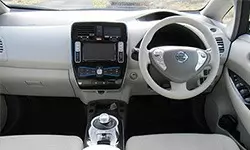

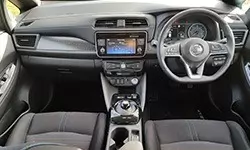
Nissan Leaf
The Nissan Leaf is regarded as the pioneer of all-electric cars. It took over six decades of finetuning, but the first ever model of the Leaf was introduced to the market in 2009 and sales began in 2010. It proudly became the first electric vehicle to be mass-produced and immediately became a hit around the globe.
Over the years, Nissan listened to the community of owners and introduced an update in almost every sales year. From 2013, Nissan obtained a manufacturing facility in Sunderland, UK and began a new generation of UK Leafs. It incorporated a faster onboard charger which almost halved its charging time. There was also an update to the upholstery of specific trim levels.
From 2015, Nissan introduced a larger 30kWh battery as standard across all trims- up from the initial 24kWh. This added an extra 30-40 mile range to a single charge, further increasing its appeal amongst competitors, who by this point have realised the potential of the market and introduced their models of electric vehicles.
The latest update to the Nissan Leaf family is the introduction of the Nissan Leaf 2018- the second generation of Nissan Leaf. The design closely assembles a conventional hatchback, featuring a less futuristic design in comparison to its predecessor. It's supplied with a generous 40kWh battery which promises up to 150 miles in a single charge. The charging time has also been significantly reduced to only 7.5 hours from a domestic 7kW charger. With a CHAmeDO rapid charger, you can gain 80% of charge in as little as 40-60 minutes.
There is also an additional trim level available, putting the total at 4. From the most basic Visia to Acenta, N-Connecta and at the other end of the scale you have the Tekna. To commemorate the launch of the new generation, there is also a limited launch edition called Nissan Leaf 2.Zero, which sits between the N-Connecta and Tekna in terms of specifications.
Tesla Model S
Tesla has taken an entirely different approach to promoting emission-free motoring. Their avenue into the electric car market started with the Tesla Roadster, which was in production from 2008-2012. It's a luxury performance sports car with- to put simply- all the bells and whistles. Naturally, it's a pure-electric car which was marketed to those with deep pockets. Tesla then used the profits from the Roadster to develop a more affordable and accessible, and hence we have its younger sibling, the Model S.
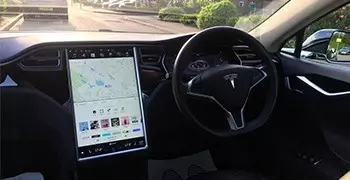

The Model S was announced in June 2012, it soon became the best selling electric car in multiple markets around the globe, and sits a close second to the Nissan Leaf in the total number of units sold. It's not difficult to see why- the sleek, minimalistic design is a huge attraction to say the least. The shape of the body also helps to reduce the aerodynamic drag and improve efficiency. It scored a perfect 5.0 on the NHTSA automobile safety rating, earning the title "NHTSA's Safest Car". The exterior shell is primarily made from aluminium, with steel only used reinforce specific areas. In 2016, the design of the Model S was slightly updated to match the exterior of the Model X closely.
The battery supplied as standard on a Tesla Model S is an impressive 70kWh battery, with 85kWh available as an upgradable optional extra. At the top of the range, the 100kWh battery is capable of covering 335 miles, higher than any other pure-electric cars currently available on the market. From depletion, the battery can be charged to 80% capacity in a mere 40 minutes.
There are currently four trim levels available on the Model S, with the only difference being the size of the battery supplied. The name of the trim levels carries a hint to the capacity of the battery- 70D, 85D, 90D and P100D. There are standalone extras which can be included, such as autopilot and the sub-zero weather package.
Tesla Model X
The Model X is the latest addition to the Tesla family; it's also the only vehicle featured on this guide which isn't a hatchback (apart from the Twizy which is a heavy quadricycle). The Model S' younger sibling was introduced in 2015 and wastes no time in becoming the world's seventh best-selling pure-electric car. It's classified as an SUV and proudly bears the same design style as the Model S.
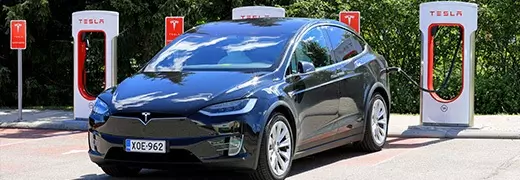

Available in 7 classic colours including a metallic red and midnight silver, the exterior of the Model X oozes elegance and luxury. It's polished shape, and aerodynamically efficient design is not the only trick up its sleeve. The gullwing doors are available as standard to access the second and third rows, which can be configurated as seating or storage space. The maximum passenger capacity is seven people- and even still you will have a generous boot space leftover.
The smallest battery supplied is a generous 75 kWh, covering up to 259 miles of range in a single charge. That is almost as wide as Britain from the west coast of Wales directly across to Ipswich. Buyers can upgrade to a 100kWh battery, pushing the range to 351 miles. If you are willing to sacrifice a small amount of mileage for performance, the P100D proudly sports the fastest 0-60mph time- a mere 2.9 seconds (that's shorter than the time it takes to read this sentence!).
Aside from the battery size, there is little difference between the trim levels. Much like the Model S, the standard equipment of the Model X is more than generous, with a 17" touchscreen infotainment which incorporates the vehicle statistics and a built-in sat-nav system. The panoramic windscreen extends to above the driver's head for an unrivalled view.
All Tesla owners have access to Tesla's expanding Supercharger network, which provides unrivalled 90-100kW of charge, For a model X, a Tesla supercharger will add 80% of charge in 40 minutes. There are almost 10,000 superchargers available throughout Europe, spread between 1,200 charger stations.
Renault Zoe
The development of Renault Zoe began in 2005 as a concept for a city car. Despite bearing no resemblance in appearance nor specification to the actual model which was produced later, it was the first time the name had been used. Subsequently, in 2009, the first electric Zoe concept was announced by Renault at the Frankfurt Motor Show. In the next year, the first preview of the Zoe was revealed to the public and went into production in 2012.
The production model of the Renault Zoe is sleek and simplistic. Unlike the first generation of Nissan Leaf which features a futuristic design, the Zoe bears a close resemblance to a conventional small hatchback for mass market appeal. The overall design and the specifications proved a great hit with markets around the world, quickly becoming the best selling electric car in France.
Designed as an urban supermini, the Renault Zoe is supplied with a 22 kWh lithium-ion battery which delivers between 60-80 miles of range, dependent on the road conditions and driving style. The unique "Caméléon" charger allows the Zoe to be charged at any level, unlike some of its competitors which has separate charger ports for different levels of charging. The charging time ranges from 30 minutes to 9 hours.
In October 2016, Renault developed a 41 kWh battery which is compatible with the R240 motor (now renamed to R75/90), increasing the range to 190 miles under NEDC. In 2018, the already impressive range of the Zoe was further increased to 250 miles under NEDC with the introduction of the latest R110 motor. Not only is there a range of contemporary colours to choose from, but there are also additional driver conveniences such as Android Auto and a comprehensive entertainment system.
It's worth noting that while the introductory price for the Renault Zoe is much lower than some of its competitors, the owner of the vehicle will be leasing the battery from Renault at an additional cost. This does, however, means that if the battery deteriorates and requires changing, the cost is covered by Renault.
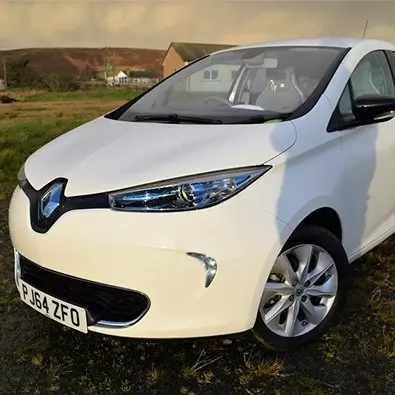

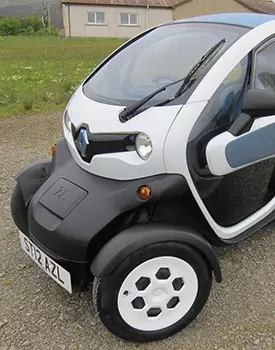
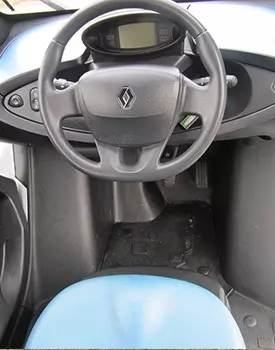
Renault Twizy
The quirky Twizy is certainly one to turn heads in the street. Legally classified in Europe as a heavy quadricycle, it's a delicate balance between a motorcycle and a "proper" car. The concept for the Twizy was announced in 2009 at the Frankfurt Motor Show and after fine-tuning, the design went into production in May 2011.
At first glance, the Twizy may remind you of a mobility scooter- one with a rain cover. Despite its unassuming looks, it was the best selling Plug-in Electric Vehicles in Europe for the year of 2012. Under its compact bonnet is a 17bhp electric motor which delivers up to 62-mile range with a top speed of 50mph. Its 6.1kWh battery can be fully charged in 3.5 hours.
There are several varieties of the Twizy available, starting at the Urban 45 which legally classifies as a light quadricycle. With a 5hp motor and a max speed of 28 mph, it can be legally driven in most European countries by most 14-year-olds with a special license.
As you might expect, the price of Renault Twizy is a far cry from the other electric vehicles on the market. Priced at an affordable £6,995 for the basic Expression trim. The price is not inclusive of Renault's mandatory battery lease, which also includes breakdown recovery during the time of the lease and free replacement should the battery fall below 80% capacity.
You may want to consider the Renault Twizy if you often travel in an urban area. With zero emissions, it's exempt from road tax and any congestion charges. While it's not narrow enough to weave in between traffic like conventional motorbikes, the sharp steering and futuristic design will ensure that you get to and from work in style. It features optional scissor doors which are, curiously, not watertight. The door is only half height with an optional plastic zip-on window.
VW E-Up!
Since 1937, VW has become one of the most successful automobile manufacturers for their renowned reliability and efficient engineering. Over the years they have created some of the most iconic cars, including the VW Beetle and the T2 "Splity" campervan. They officially stepped into the electric car market with the introduction of the e-Golf in 2012 and e-Up! (exclamation mark mandatory) in 2013, both electric versions of existing favourites.

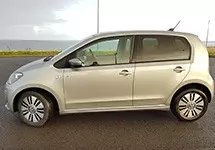

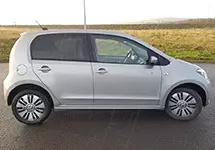
Since its unveiling in 2011, the small city car in the form of Up! has captured the hearts of many. It's an agile and stylish hatchback which navigates urban areas with ease. The electric version, the e-Up! runs from the same production line and has very little visual difference to the conventional model. This is a different approach from other manufacturers who have developed dedicated electric models (Nissan Leaf being a prime example). The shared parts between the two models also contribute to lowering costs.
It's 18.7kWh battery is supplied entirely within the cost of the car, delivering up to an impressive 99 miles in a single charge. Its top speed is 83 mph- plenty for handling the daily commute and running errands. Much like its competitors, there are levels of charging capabilities which allow the battery to be charged up to 80% in under 30 minutes.
The Up! has always been praised for its roomy interior and e-Up! makes no compromises. The boot loses a mere lire and the rest remains the same, even the dashboard controls. This is a convenient feature for those upgrading from the standard model. There are five colours available to choose from, including the bold metallic honey yellow. There is only one trim option to the e-Up! but it's generously supplied with a companion app, cruise control and built-in navigation system.
VW E-Golf
The Golf has been a firm favourite since its first ever incarnation in 1974 and remains one of the VW's best selling vehicles of all time, and proudly claims the silver medal position of the world's best selling car model. The all-electric version was introduced in 2013 by VW as part of their venture into the zero-emission car market. Much like their first attempt, the e-Up!, they have "converted" an existing model rather than developed a dedicated line of electric cars.
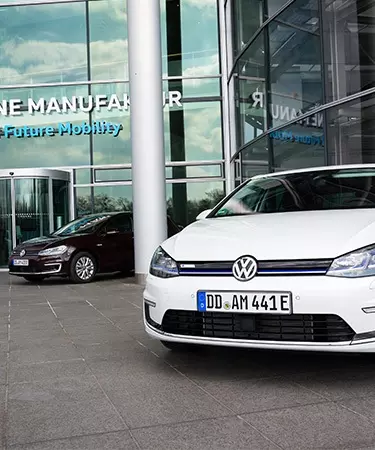
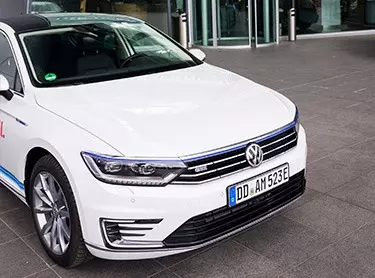
At first glance, there is little doubt that it's a Golf. A small change in the configuration of the headlights and the aerodynamically optimised alloy wheel (and of course, the logo at the back which says "e-Golf") is all that gives it away. It's a practical and ideal solution for families who make frequent trips in urban areas. The dimensions are similar to its conventional sibling and reportedly drives like it too. It's not difficult to see why VW has chosen to build on existing models- the Golf has a long prestige and is well-known for its classy appearance, which the e-Golf inherits.
Under the bonnet is a 114bhp motor which is supported by a 26.5kWh battery, promising to cover 93 miles in a single charge cycle. In 2018 this received a subtle upgrade to 35.8kWh battery which extended the range to 186 miles- doubling its previous range. The charging time varies between 17 hours to as little as 45 minutes with a 45kW rapid charger.
The two trim levels, SE and SEL Premium, are both given generous amounts of standard equipment, including an infotainment screen, Bluetooth connection and leather-wrapped steering wheel. However, only available on the SEL Premium is the Driver Assist package which includes lane assist, park pilot and adaptive cruise control.
Priced from £28,230, the Golf is not the most affordable family car around, but when you factor in the timeless style, low running costs and contribution to keeping the planet clean, it's definitely worth the premium.
Citroen C-Zero
Citroen and its sister company Peugeot are no strangers to electric vehicles, having produced electric versions of their best selling van- the Berlingo, in 1998. The Citroen C-Zero is a joint venture with Japanese firm Mitsubishi and debuted in 2010. As with previous joint ventures, there is virtually no difference between the Mitsubishi MiEV, the Citroen C-Zero and the Peugeot iOn apart from the badge.

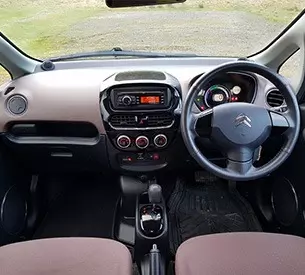
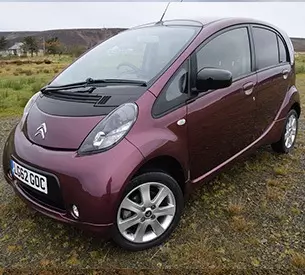
The Citroen C-Zero has been aptly named to fit in with the naming pattern of the Citroen's other models. It resembles a C1 with a heavily slanted windscreen which increases the aerodynamic efficiency. It's available in several bright and eye-catching colours, including a contemporary metallic rich plum.
There is only one trim of the Citroen C-Zero available, supplied with a 16kWh battery as standard. It promises up to 90 miles of range in optimal weather conditions a top speed of 80mph. There are both CHAmeDO "rapid" and Type 2 charger ports available on the vehicle to enable adaptability with different charging stations depending on your needs. Depending on the level of charge, it can charge from depletion to 80% in a little as 20 minutes. If you are using a domestic 220v charger, your C-Zero will be ready to go in roughly 7 hours.
Designed as a compact city car, the C-Zero makes no compromise on the interior space and comfort. It comfortably sits four adults with a generous boot space for shopping and luggage. It's agile and responsive handling is ideal for navigating narrow city streets.
Hyundai Ioniq
The Hyundai Ioniq is a relatively new kid on the block, and Hyundai deserves high praises for their first attempt at a Zero Emission Vehicle. The most basic model is marketed at £21,240 before any government incentives such as the £4,500 Plug-in Grant. It's currently one of the most affordable EVs in the market and, dare we say it, one of most stylish.
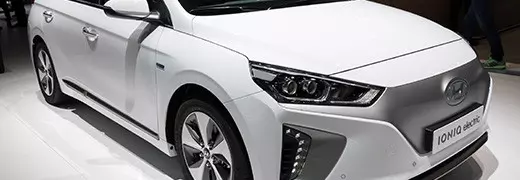
It's cryptic name is pronounced "ionic", an amalgamation of the words "ion" and "unique". The design is undoubtedly attractive and bears a heavy resemblance to a conventional small family car, ideal for urban and motorway driving. Rather unique to the Ioniq, it's available in three powertrains: you can choose from a hybrid, plug-in hybrid, or entirely electric. For the purpose of this article, we will be focusing solely on the pure electric model.
It's available in three trims- SE, Premium and at the top of the range is the Premium SE. Although the most basic, the SE is anything but. It's generously equipped with cruise control, parking sensors and alloy wheels. A step up to the Premium and you will be the proud owner of a built-in satnav system and heated seats, and the Premium SE offers leather upholstery.
Regardless of the trim level, all Ioniqs are equipped with a 28kWh battery which promises up to 110 miles of range in a single charge. At a DC charging station with 100kW, it can be charged to 80% in 24 minutes. Hyundai has announced plans to increase the range to 200 miles by 2018. Perhaps the most impressive is that the Ioniq has become EPA's most efficient vehicle by late 2016, achieving 136 miles per gallon gasoline equivalent (mpg-e).
BMW i3
Since it was founded in the 1910s, BMW has been the industry leader in affordable luxury cars. They are an established force in the motoring and motorsports industry, having produced some of the history's most iconic cars, including the E30 M3. They began the design and production of their electric car range around their centennial anniversary, announcing concept versions of the i3 all-electric car and the i8 plug-in hybrid in the 2009 Frankfurt Motor Show.
Production for the i3 began in July 2013 and quickly climbed to be the third best-selling electric car of all time. It's designed as a high-roof city hatchback and proudly bears the split BMW grilles like the others in the family. There are three trim levels available, all sporting the same 22kWh battery and 170hp electric motor, delivering up to 100 miles of range in a single charge. The battery can be charged from 0-80% in as little as 30 minutes with rapid charging.
Unique to the BMW i3, there is an additional "Range Extender" model available, abbreviated to "REx". A 647cc petrol engine is incorporated in the vehicle, designed to be only used as a backup generator to last between charges. In July 2016, a new version of the i3 was introduced with an improved 33kWh battery pack and pushing the range up to 180 miles in the NEDC.
There are three "worlds" available to differentiate between the trim levels. The most basic Mega World features a light grey interior, upgrading to part natural leather in the Giga World and full leather interior in the high-end Tera World. Instead of rigidly including it in the trim specification, BMW has offered standalone packages for optional extras such as rearview cameras, navigation systems for owners to bespoke configure their i3.
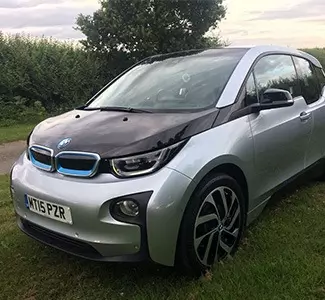

We hope this guide to the best electric cars has helped you decide which electric car is right for you. Eco Cars are specialists in pure electric vehicles.
All of our own cars are electric and we regularly engage with other electric car owners in the community to share any tips and advice.
If you have any questions about our vehicles, or about electric cars in general, please get in touch on 01856751730 or use the contact form on this website to forward your query. We will be more than happy to help.
Are you looking to buy a used electric car in Inverness, Aberdeen, Dundee, Glasgow, Edinburgh? We offer the best deals for electric cars throughout the UK. You can view our current available stock via the link below:
Second Hand Electric Car Deals

